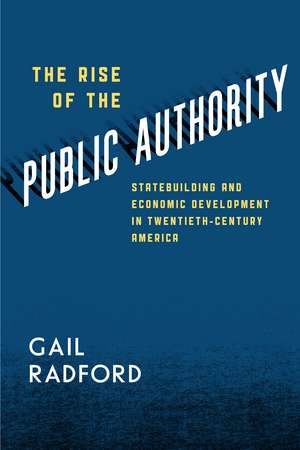The Rise of the Public Authority: Statebuilding and Economic Development in Twentieth-Century America
Autor Gail Radforden Limba Engleză Paperback – 19 iul 2013
In the late nineteenth century, public officials throughout the United States began to experiment with new methods of managing their local economies and meeting the infrastructure needs of a newly urban, industrial nation. Stymied by legal and financial barriers, they created a new class of quasi-public agencies called public authorities. Today these entities operate at all levels of government, and range from tiny operations like the Springfield Parking Authority in Massachusetts, which runs thirteen parking lots and garages, to mammoth enterprises like the Tennessee Valley Authority, with nearly twelve billion dollars in revenues each year.
In The Rise of the Public Authority, Gail Radford recounts the history of these inscrutable agencies, examining how and why they were established, the varied forms they have taken, and how these pervasive but elusive mechanisms have molded our economy and politics over the past hundred years.
Preț: 160.10 lei
Preț vechi: 199.25 lei
-20% Nou
Puncte Express: 240
Preț estimativ în valută:
30.64€ • 31.65$ • 25.50£
30.64€ • 31.65$ • 25.50£
Carte indisponibilă temporar
Doresc să fiu notificat când acest titlu va fi disponibil:
Se trimite...
Preluare comenzi: 021 569.72.76
Specificații
ISBN-13: 9780226037721
ISBN-10: 022603772X
Pagini: 232
Ilustrații: 5 halftones, 3 line drawings, 1 table
Dimensiuni: 152 x 229 x 18 mm
Greutate: 0.31 kg
Ediția:New.
Editura: University of Chicago Press
Colecția University of Chicago Press
ISBN-10: 022603772X
Pagini: 232
Ilustrații: 5 halftones, 3 line drawings, 1 table
Dimensiuni: 152 x 229 x 18 mm
Greutate: 0.31 kg
Ediția:New.
Editura: University of Chicago Press
Colecția University of Chicago Press
Notă biografică
Gail Radford is associate professor of history at the University at Buffalo. Radford is the author of Modern Housing for America: Policy Struggles in the New Deal Era.
Cuprins
Introduction
1. The Campaign for a Federal Fleet Corporation
2. The Creation of the Federal Land Banks
3. Municipalities Struggle to Meet New Needs
4. The Truncated Career of Autonomous Federal Agencies
5. The Federal Government Promotes Public Authorities
6. Public Authorities since the Second World War
Epilogue. The Future of Public Authorities
Appendix. Federal Corporate Agencies
Notes
Index
Recenzii
“Gail Radford has performed a real service here, deftly situating the first comprehensive history of this sprawling but underappreciated aspect of American governance within broader narratives of modern US history. As she explores the histories of agencies like the Federal Farm Land Bank and the Buffalo Sewer Authority, Radford’s prose absolutely crackles—this is a real page-turner!”
"At a time when many Americans express a deep frustration with government in the United States, Gail Radford provides a crucial new perspective on how the American state actually works—and into how that state was built. Rise of the Public Authority breaks down conventional categories of American political development by tracing a critical form of state capacity that operates across federal and subfederal levels of government and, more often than not, out of the public eye. Gail Radford makes this rarely recognized and even less understood capacity vitally clear."
"Gail Radford is an imaginative student of American statecraft whose probing narrtaive has put an otherwise prosaic set of agencies and institutions close to the center of our understanding of statebuilding. By explaining how quasi-governmental state authorities became such a pervasive part of the way virtually every level of government finances its activities, Radford unlocks a puzzle: how so many Americans can both distrust their state and also insist upon an ever-expanding set of governmental services. This is an important and provocative book."
“In a lucid, concise, and compelling synthesis, The Rise of the Public Authority brings a historical sensibility to the evolution of extramural state building in the twentieth century. . . . It convincingly conveys the need for deep historical analysis rather than overarching theory to understand the growth of the American state.”
“This is rich and largely unfamiliar material, and Radford’s book is indispensable reading for any who seek to understand the whys and wherefores of American state-building in its formative years.”
